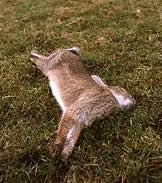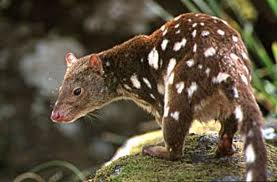The Threat to Wildlife
Secondary Poisoning
 Although some rabbit carcasses may be collected before they are eaten, predators are still at risk from dying rabbits: “Rabbits dying from pindone poisoning can become lethargic and less aware of their surroundings. This can predispose these animals to predation which can in turn place predators at greater risk from secondary poisoning” (Sharp & Saunders 2004a).
Although some rabbit carcasses may be collected before they are eaten, predators are still at risk from dying rabbits: “Rabbits dying from pindone poisoning can become lethargic and less aware of their surroundings. This can predispose these animals to predation which can in turn place predators at greater risk from secondary poisoning” (Sharp & Saunders 2004a).
A paper published by the NZ Department of Conservation noted that “Reports of anticoagulant residues in predatory birds” and other wildlife “appear to have increased over the last decade, heightening worldwide concern regarding non-target effects” of anticoagulant  pesticides. The researchers found that, in terms of secondary poisoning, pindone “has a high risk profile to birds and a medium risk to mammals” (Fisher et al 2004: 6).
pesticides. The researchers found that, in terms of secondary poisoning, pindone “has a high risk profile to birds and a medium risk to mammals” (Fisher et al 2004: 6).
Laboratory studies have found that owls can be poisoned by eating pindone-contaminated mice carcasses and that “raptors appear to share the high sensitivity [to pindone] of rabbits, based on results for wedge-tailed eagles and brown goshawks” (NRA 2002: 26, 30).
Quolls are particularly at risk of secondary poisoning because they are carnivores and where rabbits are available they form a  large part of the quoll's diet.
large part of the quoll's diet.
Swamp wallabies will be at risk of both primary and secondary poisoning. They are normally herbivores, and so will readily eat carrot baits, but as occasional omnivores they will also eat dead rabbits. (Sceptics can view the YouTube video of a wild swamp wallaby feeding on a rabbit carcass below.)
 Sea eagles are likely to feed on sick rabbits and rabbit carcasses, as are goannas. There is some limited scientific evidence about the susceptibility of different native species but it is not definitive and a lot depends of how much an individual animal consumes. If there is a feast of dead and dying rabbits for carnivores then it might not mean much that some native species have greater resistance to pindone than rabbits.
Sea eagles are likely to feed on sick rabbits and rabbit carcasses, as are goannas. There is some limited scientific evidence about the susceptibility of different native species but it is not definitive and a lot depends of how much an individual animal consumes. If there is a feast of dead and dying rabbits for carnivores then it might not mean much that some native species have greater resistance to pindone than rabbits.
Denials
The response of pindone proponents to the risk of secondary poisoning is an unproven assertion that this risk is very small because the sick rabbits go back to their burrows to die, an assertion that does not fit with the recommended method of effectively poisoning rabbits that involves "a series of smaller doses over a period of 4 to 12 days" rather than one large dose. This means the rabbits are up and about for up to 12 days after taking the first bait, plenty of time for predators to find them.
In fact on Macquarie Island, where another rabbit poison was used (brodifacoum; an anti-coagulant like pindone), "More than 2200 birds - mainly skuas and giant petrels - died from eating baits or the carcasses of the rabbits and rodents" (Darby 2012).
A Thai translation of this page can be found at http://eduindexcode.com/secondary-poisoning/
